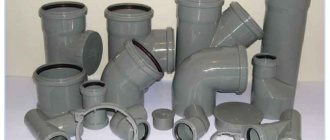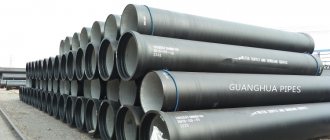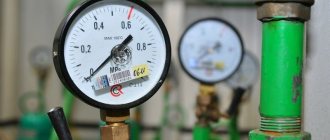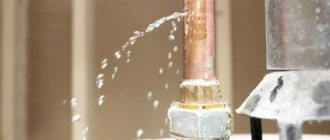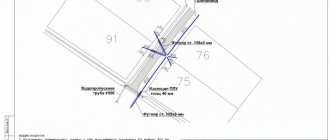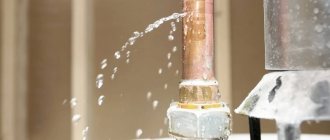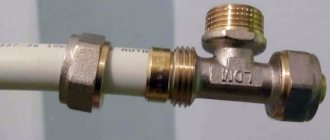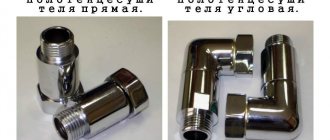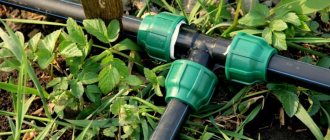Do you want to organize water supply for a country house by connecting it to the existing central highway? Automatic water supply will greatly simplify the life of household members, right? But to implement your plan, there is no way to shut off the water in the main pipeline and you need to tap into the water supply under pressure?
We will tell you how to make the connection in practice, avoiding disconnecting consumers powered from the main line - the article discusses the process of making the connection, taking into account all legal requirements. The material is supplied with thematic photographs and useful video recommendations.
Carefully studying the stages of connecting your household to the central water supply will help you avoid fines for violating existing standards when unauthorizedly tapping into a pipeline. If you wish, you can also save money by doing some of the excavation work yourself.
Steel pipe installation
Pipes made of steel are characterized by their rigidity and simultaneous plasticity. Their installation can be carried out in a manner similar to inserting polymer analogues. When working with them, you must follow a certain sequence of actions:
- the surface of the area for insertion is cleaned of corrosion deposits;
- a pipe is mounted on it;
- The seams are welded and then checked for leaks;
- the pipe is connected to a threaded or flanged valve, through which the main pipe is drilled under pressure;
- installing a new pipeline branch.
The upper layers of the main are drilled using a hammer drill, and the remaining few millimeters are worked out manually.
Required materials when connecting to the central pipeline
Depending on the material of the water pipe, it may be necessary to use certain additional pieces of equipment.
To cut into a plastic pipe with a pressure of about 1.6 MPa, it is necessary to use a ring saddle clamp. This device contains a spiral with a cutter, used when forming a hole
When purchasing a saddle for tapping into a water supply system, you should pay attention to the barcode marked on its body. It ensures the accuracy of the parameters of the created hole
To tap into a cast iron or steel pipe, you need to buy a saddle clamp. This device is divided into two parts, which are tightened with bolts during operation. The metal saddle is equipped with a locking plate.
It is mounted to the pipeline with a bracket. Insertion into a steel water supply can be carried out without the use of a saddle by welding the pipe, however, with this method, the diameter of the main pipe matters, which must have a large cross-section.
Today, thanks to their reasonable price and excellent quality, saddles with built-in valves and a cutter have gained great popularity among specialists. They are usually used when inserting into a pipeline under a pressure of no more than sixteen bar.
They are equipped with a coupling, which allows installation with a welding machine. The most attractive feature of such saddles is their good resistance to corrosion processes, extending their service life to fifty years.
The final stage of the tie-in
The final step in any pipeline connection process is to test the connected system components.
For this purpose, water under pressure is supplied to the created new branch, and the accumulated air is released from the other end of the pipe using a tap placed on it.
After checking all elements of the water supply system for leaks, you can dig a trench laid from the main line to the point of connection with the home network.
Characteristic features of saddles
A saddle for HDPE channels helps to make a high-quality sealed insert into a PE pipe; this element is considered the most effective option in such situations. It is not recommended to cut polymer pipes and connect them using a tee or compression coupling.
Firstly, large-diameter plastic elements are not particularly flexible, which can cause difficulties when the pipe enters the connecting element. Secondly, during the cutting process the pipe may become deformed, which will also cause certain difficulties. Thirdly, if dirt gets into the parts of the compression coupling, the strength and tightness of the connections will be compromised.
In most cases, the saddle for inserting into pipes made of low-density polyethylene is made from polypropylene copolymer PP-B. Finished elements with a diameter from 20 to 63 mm can be operated under a pressure of no more than 1.6 MPa if the ambient temperature is 20C. When using parts with a diameter from 75 to 110 mm, the operating pressure is reduced to 1.25 MPa.
Coordination of work on tapping into the water supply system
Only with the permission of the relevant authorities can work begin on inserting an additional pipeline into the centralized water supply system
It is important to complete all documentation before starting work. If all this is not done, then you may incur administrative and financial liability for the illegality of your actions. So, you need to start the insertion procedure in order to obtain a plan of a specific site to determine the presence of various utilities laid underground
With this document, you can go to the water utility and make a statement about your desire to connect to the central water supply system. You must also have documents indicating ownership of a specific house or plot of land.
So, you need to start the insertion procedure in order to obtain a plan of a specific site to determine the presence of various utilities laid underground. With this document, you can go to the water utility and make a statement about your desire to connect to the central water supply system. You must also have with you documents indicating ownership of a specific house or plot.
Technical parameters that you need to know about when connecting:
- strictly defined insertion point;
- diameter of the connected pipeline;
- other information required in accordance with the purpose of the work performed.
Then you need to obtain permission from the sanitary and epidemiological service. With all the above documents, you can begin to develop and sign the project and estimate for the work being carried out. Independently tapping into a pipe without turning off the water supply is strictly prohibited, as is installing metering equipment. For these purposes, there are specialists who can be called from the appropriate government or certified private organization.
It is also prohibited to insert into the following types of pipeline:
- large diameter trunk networks;
- pipelines that are subsequently not connected to the sewer drain;
- other types.
This is interesting: Profile pipe - application, type characteristics and weight calculation
What documents need to be collected and prepared?
The basis for drawing up a cold water supply contract is an application on behalf of the customer or his representative acting by proxy, or an offer from a water supply service chosen by the customer.
The application must include the following information:
- Subscriber details:
- For individuals – postal address of registration or place of residence, full name, passport details or other identity document, contact information.
- For legal entities and individual entrepreneurs – registration number in the State Register and the date of its entry, location indicating the postal and registration address at the place of residence, individual tax payer number (TIN), bank details and documents confirming the subscriber’s right to sign business documentation.
- The name and location of the object in respect of which the contract is being drawn up.
- Information about other sources of water intake, indicating the volume and owners through whose networks water is supplied.
- If standards are established for the customer for the disposal of sewage water in cases where there are no septic tanks for dachas and country houses on the site, their composition and properties are indicated in the dynamics of changes over the year.
- The area of the customer’s individual plot with the objects located on it and its characteristics.
- Data on the type of activity in the case of regulated spillways.
The list of papers submitted with the application includes the following documents:
- A photocopy of the certificate of property rights to the object or device connected to the water supply line, necessary for connection to the system.
- A copy of the passport or other document confirming the subscriber’s identity. Power of attorney for drawing up business papers, if the customer is acting as his authorized representative.
- Standard documents established by law for organizations, partnerships, housing cooperatives when drawing up agreements with resource-supplying authorities.
- Information necessary for calculating consumed volumes - the area of irrigated land, housing and auxiliary premises, the number of storeys of buildings, the number of residents.
- Photocopies of documents and previously concluded contracts for connecting the subscriber to the water supply main.
- Photocopies of reports on connection, washing and disinfection of lines and equipment on the customer’s territory inside the house and on an individual plot when connecting to the water supply main.
- Photocopies of papers for water meters to verify compliance with their legal requirements, installation diagram and information about their readings at the time of drawing up the contract. The norm does not apply to consumers with a intake volume of less than 0.1 cubic meters per hour and when the installation of meters is optional.
- Sampling site diagram.
- Photocopies of documents confirming ownership of an individual land plot.
- Balance of maximum consumption indicating the intended use and load according to needs (for household needs, fire protection, filling swimming pools, periodic water consumption for irrigation).
- A positive expert decision from a federal or private examination in cases where it is required by law.
- Documentary photocopies of papers about other sources of water supply, contracts with water supply services and their licenses for the use of subsoil, indicating the volume of supply.
Rice. 3 Plumbing diagram in a private house - example
Features of tapping into water supply systems made of metal, cast iron and plastic
In order to cut into a metal pipeline, use a saddle clamp with drilling:
- Before you begin installing the device on the pipe, it must be thoroughly cleaned of dirt (if any) and rust. In addition to the lower part, which has the shape of a semicircle, in the upper part of the clamp there is a valve with a hole for drilling directly under the drill. After the clamp is installed on the pipe, its parts are connected to each other with bolts.
- After the clamp is secured, a hole is drilled and closed with a plug using a special screw. This clamp can be used as a shut-off valve. You can also use a clamp with an already installed valve. Once the hole is ready, the drill is pulled out and the valve is closed. After which other necessary installation work is carried out.
- A special machine can be attached to a metal clamp, which consists of a handle with a ratchet, a locking bolt, a shaft with a drill at the end and a flushing tap. Everything is contained in a metal case, which is attached to the clamp using rubber seals. Due to the fact that there is a guide sleeve, you can drill in a certain direction. In this way, an insertion is made into a water pipe made of cast iron or steel.
Insertion into a plastic pipeline without reducing the pressure on it is possible using an electric-welded saddle clamp. It is made of special plastic and has a heating coil with a drilling mechanism. There is a bar code on the body of this clamp, which allows you to enter welding characteristics with the required accuracy.
- The pipe must be cleaned in advance and a clamp must be attached to it using bolts, which has terminals for connecting a welding machine.
- Using a welding machine, the spiral is heated and the outlet is welded.
- Nowadays, a saddle with a built-in cutter and valve is most often used. In order to make an insert into the water supply using welding, use a coupling.
- After everything has cooled completely, after an hour you need to use a cutter to make a hole and screw on the shut-off valve.
This method is applicable for pipelines with pressures up to 1.6 MPa.
In order to drill a cast iron pipe under pressure, clamps are used that have a special design and bimetallic crowns. In this case, the crown should not overheat, and work should be carried out at low speeds.
Stages of work when inserting a water pipe into a cast iron pipe:
- it is necessary to excavate the pipe and clean it from rust at the insertion point;
- using a grinder, cut off the top layer of hot cast iron;
- install a collapsible saddle; in order to seal the joint between the fittings and the clamp, it is necessary to put a rubber seal;
- the shut-off valve must be attached to the flange outlet, through which a crown (cutting tool) will be inserted;
- drill a cast iron pipe, cooling the cut area;
- the crown is removed from the valve and the water flow is stopped.
The pipe is drilled with a carbide crown, which will need to be changed at least 3-4 times during the entire process. Also, do not forget that it is necessary to ensure that the saddle pipe has a slope of 2 degrees towards the house.
To tap into a cast iron pipe, you need to use drills designed for working with metal!
Welding installation of a pipe to a steel water supply should only be done by qualified specialists. Installation of saddles on a cast iron or polymer pipeline is done independently, but for this it is necessary to turn off the water supply. Tapping under pressure must be carried out taking into account all the rules and recommendations, otherwise this work may pose a danger to health and material assets.
If you live in a house outside the city, then you need to arrange a water supply to your home, and to solve this issue there are two solutions - get your own well or well, or connect to a centralized line with high-pressure water. The first option is expensive, time-consuming and labor-intensive. The second solution will provide your home with water for one day, but you will be dependent on the water supply schedule (this happens in remote peripheral villages).
The positive aspect that the connection to the water supply gives is that you will receive stable pressure in the pipes, which will ensure the same stable operation of household appliances that require water supply - an automatic washing machine, dishwasher, plumbing equipment - a bathtub, a jacuzzi, a shower or even a swimming pool.
Construction of a well for the construction of a site
How to make a well.
The rules for installing a central water supply system provide for wells for inspecting the pipe and connecting new consumers. If they are located far from home, it is advisable to arrange them with your own hands at the insertion site. Such a structure will subsequently facilitate the operation of the home water supply system. A shut-off valve is installed in the well; if necessary, the water supply to the house can be stopped.
The pit dug at the connection site is deepened by 0.5 m and filled with crushed stone. Ruberoid is laid on top, 10 cm of concrete grade 200 is poured. To give strength, it is reinforced with reinforcement. A few days later, when the concrete pad has set, a shaft is erected above it. The manhole is given a round or rectangular shape, taking into account that there is 70 cm of free space inside. This is enough to fit a person to operate the valve.
To build a well, use bricks, blocks, or install well rings. If there is a threat of seasonal flooding, the structure is sealed. To do this, the hole is immediately dug wider so that there is access to the outer walls. They are treated with bitumen mastic, wrapped in roofing felt, then covered with excavated soil. You can install a plastic container of a suitable size and seal the pipe entry points well. The top of the well is covered with a lid with a hatch.
Why might a tie-in be required?
If we are talking about the main trunk line, then there may be a serious need to connect the new building to the existing water supply.
If it is necessary to make a connection to the internal water supply, this may require
for connecting any device where cold water is needed, an outdoor tap or household appliances.
This approach allows you to reduce the cost of organizing water supply, possibly improve water quality and get more pressure. In this way, you can make as many taps as you like with your own hands, even into a sewer pipe...
To do this, carefully insert your water supply into an existing one in the right place, after which a pipe is laid to the house at a sufficient depth so that the ground does not freeze - from 1.2 meters.
If the pressure in the main pipeline is sufficient, then installing a pump is not necessary. All that remains is to think about joining the sewer main.
If there is a central sewerage system, no problem. Otherwise you will have to solve the problem yourself.
If the system is outdated, with a working pressure insufficient to supply the number of houses available, which means the stream of water from the tap will be very weak. Thus, you will have to take care of increasing the pressure yourself by installing a pump.
The unit is installed directly on the pipe, and it works automatically when using a tap.
Do not forget about possible poor water quality. In this case, additional filtration will be required, for which a water treatment system is installed.
Resolution and approval
Tapping into the water supply must be carried out sequentially.
The first step is to obtain permission to tap into a water pipe, since illegal tapping into a pipe carries financial and administrative liability. First, you should get a site plan, from which you can understand how communications run underground.
The document can be obtained from the Federal Center for Land Registration.
This plan will be needed to apply to the district water utility office. Additionally, you will need to present title documents for the plot and house.
The central department is obliged to issue technical connection conditions, which include:
- pipeline diameter;
- connection location;
- other data that may vary depending on the purpose of the insert.
That's not all. These technical conditions and documents for the site and house are submitted to the SES department. Additionally, an application is drawn up to obtain a conclusion on connection to the water supply system.
Next, a contract is concluded with a company that has a license to develop design and estimate documentation. As a rule, such a group works with the water utility.
Of course, their project costs more than other organizations, but it will definitely pass the test. Therefore, savings may not be appropriate.
Then the design and estimate documentation is registered with the SES. All that remains is to obtain permission from utility organizations to carry out excavation work where your water supply will be connected to the existing network.
Complete plumbing system
Next, you need to find a team that will perform installation work. An agreement must be concluded with this organization. And here it should be noted that independent insertion into an underlying water supply pipe under pressure and installation of metering devices is strictly prohibited.
Even if you have all the permits and approvals, connecting your water supply to the existing network should be carried out exclusively by specialists.
The only way to reduce costs is to independently perform those types of work that do not require a license:
- digging a trench and backfilling it;
- adding sand;
- other similar work not directly related to the connection (purchase and delivery of pipes, reconnection to the sewer network, for example).
Unauthorized tapping into a finished plastic water supply is fraught with considerable fines and subsequent problems.
After completing all the work, water utility specialists must draw up a certificate of commissioning of the devices. All that remains is to conclude an agreement with the organization for the supply of water and payment.
Legal procedure for connecting to the water supply network
According to this document, any connection to the water main or to the sewerage system of one’s neighbor is considered an illegal tapping without concluding a consumer agreement and coordinating one’s actions with the service organization (and the neighbor).
In response, this organization draws up a Violation Report, which records the incident in detail. Prepares relevant documents and calculates possible damage caused.
After which this organization goes to court to make a decision in accordance with current legislation. Accordingly, the court imposes punishment in the form of a fine for illegal tapping into a water supply system.
For law-abiding citizens, the following procedure is provided:
- An application is submitted to the service company regarding the need to connect to the water supply;
- there they draw up technical documentation and a wiring plan;
- according to the plan, having received permission to connect, the customer digs a trench on his own and makes the wiring;
- at the appointed time, company representatives make the connection, install the meter and seal it;
- the customer enters into a consumer contract and pays the cost of these services.
At this point, the connection procedure is considered completed and the person can safely use the water supply.
Detailed description of the main stages of work: insertion into the water supply system
When deciding how to make a tap into a water supply system without turning off the pressure in the central system, you need to carefully familiarize yourself with each stage of the work. First, you need to calculate the route of the pipes. The optimal depth for them is considered to be 1.2 m. The pipes should go straight from the central highway to the house.
Materials: cast iron and others
They can be made of the following materials:
- polyethylene;
- cast iron;
- Cink Steel.
Artificial material is preferable, since insertion into the water supply system will not require welding in this case.
To simplify the work, a well (caisson) is built above the insertion site. To do this, the pit is deepened by 500-700 mm. A gravel cushion is poured at 200 mm. Roofing material is rolled out onto it, and concrete 100 mm thick is poured with a 4 mm reinforcement grid.
A cast plate with a hole for the hatch is installed on the neck. Vertical walls are coated with a waterproofing substance. At this stage, the pit is backfilled with previously selected soil.
The canal is dug manually or using an excavator. The main thing is that the depth meets the requirements of the project. It is located below the soil freezing limit in this climate zone. But the minimum depth is 1 m.
It is better to use artificial material for insertion
DIY installation in 7 steps: clamp, saddle, sewerage diagram, coupling
The installation process uses the following technology.
- The device for tapping under pressure is located in a special lining of the clamp. This element is installed on a pipe that has been previously stripped of thermal insulation. The metal is rubbed down with sandpaper. This allows you to remove rust. The cross-sectional diameter of the outgoing pipe will be narrower than that of the central one.
- A clamp with a flange and a pipe is installed on the cleaned surface. A shut-off valve with a bushing is mounted on the other side. The device in which the cutter is located is attached here. With her participation, integration into the overall system is carried out.
- A drill is inserted into the pipe through the open valve and the seal of the blind flange. It should match the size of the hole. Drilling is in progress.
- After this, the sleeve and cutter are removed, and the water valve is closed in parallel.
- The inlet pipe at this stage must be connected to the flange of the pipeline valve. The protective coating of the surface and insulation materials are restored.
- Along the route from the foundation to the main canal, it is necessary to provide a slope of 2% from the tie-in to the inlet outlet pipe.
- Then a water meter is installed. A shut-off valve is mounted on both sides. The meter can be located in a well or in a house. To verify it, the shut-off flange valve is closed and the meter is removed.
This is a general tapping technology. The puncture is carried out in accordance with the type of material and design of the reinforcement. For cast iron, grinding is carried out before work, which allows the compacted outer layer to be removed. A flanged cast iron valve with a rubber-coated wedge is installed at the insertion point. The pipe body is drilled with a carbide bit. What matters here is what material the cutting element is made of. A cast iron flanged valve requires the use of only durable crowns, which will have to be changed about 4 times during the tapping process. Pressure tapping into a water pipe is carried out only by competent specialists.
For steel pipes it is not necessary to use a clamp. The pipe needs to be welded to it. And a valve and a milling device are already attached to it. The quality of the weld is assessed. If necessary, it is further strengthened.
The polymer pipe is not sanded before the pressure tapping device is placed on the puncture site. A crown for such material can be either strong or soft. This is another reason why polymer pipes are considered beneficial.
The next stage involves conducting a test. Shut-off valves (flange valve, gate valve) and joints are checked for leaks. When pressure is applied, air is released through the tap. When water begins to flow, the system is inspected with the channel not yet buried.
If the test is successful, a trench and pit are buried above the insertion site. The work is carried out in compliance with safety regulations and in accordance with the instructions.
This is a reliable, productive method that allows you not to disturb the comfort of other consumers. Work can be carried out in any weather
That is why the presented method is so popular today. Connecting to the water supply is a very important technical event.
How to connect to a public water main
Before cutting into a water pipe under high fluid pressure, familiarize yourself with three technology options, which vary depending on the material from which the pipes are made (they can be polymer (PP), cast iron, galvanized steel).
For a polymer central route, an insertion into a water supply pipe under pressure looks like this:
- A trench measuring at least one and a half meters is dug, the area where the work will be carried out is exposed, and a trench is dug from there to the house;
- At the end of the excavation work, a saddle is prepared for insertion into the water supply system - this is a collapsible crimp clamp that looks like a tee. The straight branches of the saddle are divided in half, and a tap is installed on the vertical branch to shut off the pressure. Using a special nozzle, a pipe is drilled through the tap for tapping. The most reliable saddle design is a collapsible welded one. Such a clamp can be easily divided into two halves, assembled above the insertion area, and connected by welding to the main route. Thus, the clamp for tapping into the water supply is welded into the body, providing a reliable and completely sealed water supply to the housing;
- The pipe is drilled with a conventional drill and electric drill. Instead of a drill, you can use a crown, but the result is important, not the tool;
- A through hole is drilled until a stream of water comes out of it, after which the drill is removed and the valve is closed. For safety reasons, at the end of the drilling process, the electric tool is replaced with a hand drill or brace. If you drill a hole not with a drill, but with a crown, it will automatically ensure the tightness of the drilling site. In addition to these options, there is a solution using a special cutter, which is rotated with an adjustable wrench or an external brace;
- The last stage of inserting into the central water supply system is to install your own water supply system, laid in the trench in advance, and connect it to the central route with an American crimp coupling.
To fully control the insertion site, it is advisable to arrange an inspection above it - a well with a hatch. The well is set up in a standard way: a gravel-sand cushion is made at the bottom, reinforced concrete rings are lowered into the trench, or the walls are laid out with bricks. Thus, even in winter it will be possible to shut off the water supply if it is necessary to repair it in the house.
For a central water supply pipe made of cast iron, tapping using the saddle method looks like this:
- To tap into a cast iron pipe, it must first be thoroughly cleaned of corrosion. At the very point of drilling, the top layer of cast iron is removed by a grinder by 1-1.5 mm;
- The saddle is built into the pipeline in the same way as in the first point, but to completely seal the joint between the pipe and the crimp, a rubber seal is laid;
- At a further stage, a shut-off valve is attached to the clamp nozzle - a tap through which the cutting tool is inserted.
- Next, the body of the cast iron pipe is drilled, and do not forget about the need to cool the cut site, as well as change the crowns in a timely manner.
- A hole is drilled for insertion into the main water supply using a carbide or diamond bit;
- The last step is the same: the crown is removed, the valve is closed, and the insertion site is scalded with special electrodes.
A steel pipe is a little more ductile than a cast iron one, so pipe insertion is carried out using a method similar to the solution with a polymer main, but a saddle is not used, and before inserting into a galvanized steel water supply, the following steps are carried out:
- The pipe is exposed and stripped;
- A pipe made of the same material as the main pipe is immediately welded onto the pipe;
- A shut-off valve is welded or screwed onto the pipe;
- The body of the main pipe is drilled through the valve - first with an electric drill, the last millimeters - with a hand tool;
- Connect your water supply to the valve and the pressure connection is ready.
Pipeline tapping methods
To decide on the work algorithm and the necessary equipment, you should first choose the insertion method itself. There are only two of them:
- into the main pipeline;
- into the built-in pipeline.
High pressure is concentrated in the main pipes, so all work is carried out carefully. Working with built-in pipelines is much easier, because the pressure there is less and the structure is thinner
Water will not flow out with strong pressure when making a hole.
Pipes are made from the following materials:
- steel;
- cast iron;
- polyethylene.
Based on the material from which the equipment will be made, the method of insertion into the pipeline under pressure is selected.
How to tap into a steel pipe
Steel is distinguished by such properties as rigidity and flexibility. When carrying out work, it is necessary to comply with all the rules so that the highway does not break in the future:
- clean the pipeline section from plaque, dirt and corrosion so that nothing interferes with the work process;
- fix a clamp on the cleaned part for working with equipment under pressure;
- weld the seams;
- check the tightness of the pipe;
- use a valve to make a hole;
- quickly connect a new section of pipe, and then drill the upper section with a hammer drill.
How to tap into a cast iron pipe
To install additional pipes to cast iron material, you must use a coupling. Tapping into a cast iron pipe under pressure should be done in stages:
- clean the surface;
- fix the rubber seal on the area;
- attach shut-off valves to the outlet; they will help install the crown;
- start drilling a hole with a hammer drill, gradually increasing the diameter as you cut;
- close the valve after removing the crown;
- Apply compounds to the surface that will prevent the formation of corrosion.
Methods
Often the material of the water supply pipeline determines both the material of the branch line pipe and the insertion method. If the central or secondary pipe is steel, then it is also better to use a steel pipe. As a last resort, make a transition section in the form of a fitting made of a steel pipe with a valve, to which then connect a pipeline made of another material.
Tapping of steel pipes is done in two ways:
- using a welding machine by welding a fitting to the water supply;
- using a steel clamp without welding.
Both methods are used both when tapping into a pipeline that is under pressure and without pressure. But on high-pressure pipelines, welding is recommended to be used only in emergency, emergency cases, as well as when organizing additional safety equipment. In the normal mode of work, actions are required to completely shut off the section of the water pipeline where the tie-in is made using welding.
The algorithm for working with welding on an existing pipeline is as follows:
- a hole is dug with an excavator to a level above the laid pipeline of approximately 50 cm;
- the section of pipe into which the insertion is planned is manually cleared of soil;
- the insertion site is cleared of anti-corrosion coating and other protective layers, and the specific area of connection of the fitting or branch pipeline is cleaned to shiny metal;
- the fitting is welded to the tap;
- after the metal heated by welding has cooled, a drill is inserted into the fitting through the tap and a hole is drilled in the wall of the water supply;
- when water flows through the fitting, the drill is removed and the tap is closed (the insertion is completed, further laying of the water supply line begins from the valve on the fitting).
A mortise clamp is a simple piece consisting of two halves of semicircular shapes. These halves are put on the pipe and tightened together with bolts and nuts. They differ from ordinary clamps only in the presence of a threaded hole on one of the metal parts. A fitting is inserted into this hole, serving as part of the outlet line. The hole for the pipe can be located anywhere in the water supply system, and when screwing in the fitting, it will always be at right angles to the linear plane of the pipeline surface.
The rest of the process is similar to tapping using welding: a drill is inserted into the fitting through a tap and a hole is drilled. If the tap is of small diameter and the pressure in the water supply is within 3–4 kgf/cm², then the tap can be screwed on without any problems even after drilling (if it is threaded and not welded). Additional lines are also connected to the cast iron main using clamps.
Insertion into pipes made of plastic or polyethylene occurs using plastic clamps or saddles (half-clamp with fasteners). Clamps and saddles can be simple or welded. Working with simple devices is not much different from inserting a clamp into a steel pipe. And welded saddles or clamps contain all the equipment necessary for welding. This saddle assembly is installed on the pipe in the intended location, the terminals are connected to electricity, and after a few minutes the insertion will be automatically completed.
Approval stage
All work related to tapping into the pipeline is allowed to be carried out only after obtaining permission from the relevant authorities. If the water supply drainage and installation of an additional circuit are carried out without approval, the owner of the property will bear administrative responsibility for illegal work, which is expressed primarily in substantial fines. To obtain a permit, you need to collect a whole package of different documents.
- Site plan. It is necessary to clarify the location of all communications that are laid underground.
- Documents certifying your rights to own the specified plot or building.
- An application to the authorities responsible for water supply (a sample of it can be found on the Internet or at a stand in the organization itself).
- Approval from the sanitary-epidemiological station.
- Connected system project.
The incoming pipe is selected with a smaller diameter
When developing the latter, you need to accurately determine the insertion location, take into account the diameter of the pipeline that you intend to connect, and a number of specific parameters, the set of which may vary depending on specific conditions.
In addition, there are certain restrictions on tapping into the pipeline. Diversion from the highway is prohibited if:
- The main pipe has a large diameter.
- The pipeline is not included in the cycle with discharge into the sewer system.
There are other frames that are much less common, so we will not list them.
When planning to start tapping into the water supply system, the owner of the site must remember that carrying out work without turning off the water pressure is strictly prohibited. As well as installing meters. All manipulations with the main line and branches from it must be carried out by specialists - either from a government agency or from a private company that has passed the appropriate certification and received a license for the necessary work.
Inserting into the main system and using clamps is a matter for professionals
How to properly cut into a plastic water pipe
Do you have plastic communication systems in your private home and do they require modernization or repair? It’s not difficult to install plastic yourself, thanks to the features of this material, right? But how to cut into a plastic pipe when it is under pressure? And is it possible to do this yourself?
We will give you answers to your questions - the article discusses several ways of tapping into a pipe to organize a diversion from an existing main. Starting with the simplest thing - shut off the pipeline for a while and insert a tee in the right place, having previously cut out a section.
By following the recommendations given in the videos, you can do most of the work on your own without involving qualified specialists.
Method #3 - crimp clamp (overlay)
In addition to the electric welded saddle, there is a simpler analogue - an overhead clamp. It consists of two separate parts bolted together.
One to put on top of the plastic pipe, and the second from below to pull the top part. A sealing gasket is additionally inserted between them to prevent leaks.
Inset diagram. The number of tightening bolts and the dimensions of the clamp depend on the diameter of the pipeline into which the insertion is made
Typically, the upper and lower overlay parts exactly match the dimensions of the pipe. But there are also universal clamps, in which the top is made small, and instead of the bottom there is a metal strip for a tie.
Outwardly, they resemble repair analogues for connecting with a hose or closing fistulas. Only in the upper part do they have a pipe for connecting the outlet.
Clamps for inserting into a plastic pipe are:
- with shut-off valve;
- with built-in cutter and safety valve;
- with a flanged or threaded end made of metal;
- with a plastic end for soldering or gluing.
To make an insertion, the clamp is put on the pipe and secured to it with nuts or bolts, depending on the design. Afterwards, drilling is carried out through the existing outlet pipe. And then the branch itself from the main is connected.
It is not recommended to drill a pipe without installing a clamp or saddle on it. You can make a mistake with the drill diameter and drilling point. It is best to do this through the branch pipe of the fitting already installed for the branch.
So the drill will definitely be slightly smaller in size than the internal section of the embedded outlet and will be installed exactly where it is needed.
The nuances of working on a water pipeline under pressure
For insertion into the pressure pipeline, electric-welded saddles and clamps with a built-in cutter are used. It is located in a special sealed nozzle housing.
To drill into plastic, it is often enough to turn it with a hex key. But there are also models for a drill.
The presence of a sealed branch with a cutter inside ensures that there is no splashing of water when drilling a pipe under pressure
Some similar designs have a built-in valve. Then, after drilling is completed, the cutter is raised, the valve is closed, and the attachment with the drill is removed. Instead, a drain pipe is installed.
The use of linings with an internal cutter allows you to cut into any water pipes
It doesn't matter whether they are under pressure or not. But such attachments are much more expensive than conventional clamps and saddles. https://www.youtube.com/embed/-jbp8mRjchg
They greatly simplify the insertion process, but you will have to spend money on them. At the same time, in terms of the tightness of the resulting connection, they are neither superior nor inferior to standard solutions.
Conclusions and useful video on the topic
There are many nuances in connecting a branch to a plastic pipeline. There are different types of plastics, fittings in design, and insertion methods.
To avoid serious mistakes, we recommend that you watch the videos below on this topic.
Tapping into a HDPE pipe under pressure using a saddle with a cutter:
Features of installation of an electric welded saddle:
The nuances of inserting into a polyethylene water supply:
It's rare to cut into existing plastic plumbing. But sometimes you need to change pipes, install water meters, or simply connect additional plumbing. There are several different types of fittings and tapping technologies available for this purpose.
For any case, there is an optimal option so that you can carry out the installation yourself. It is necessary to entrust these works to professional plumbers only in the situation of connecting to a public water supply, where preliminary approvals are required.
The essence of the process
To connect the outlet to the main pipe, you need to drill a hole in it and attach the outlet pipe using soldering or various types of fittings.
If it is impossible to turn off the water supply, the hole and connection are made using special clamps.
During the operation, two general conditions must be met:
- the diameter of the drill and the diameter inside the outlet pipe must match;
- The additional pipe is smaller in diameter than the main one.
Tapping into a cast iron pipe
Here the approach should be slightly different. Metal is many times harder than polymer, but at the same time has low plasticity, and therefore a cast iron pipeline can burst under strong physical impact. Therefore, the following stages of work are followed.
- After digging out the pipe at the insertion point, it is cleaned of rust. Where the breakdown is intended, the outer layer of hot metal is removed using a grinder.
- A collapsible saddle is mounted on the line, and a rubber seal should be placed between the clamp and the base - it seals the joint.
- A shut-off valve is fixed to the outlet of the saddle. The hole punching crown is inserted through it.
- When drilling, it is necessary to regularly change the bits (they will become dull quite quickly) and constantly cool the puncture site.
After making a hole in the pipe body, the crown is removed and the water is shut off. The installation of the outlet leading to the meter from the saddle is carried out in a standard manner.
